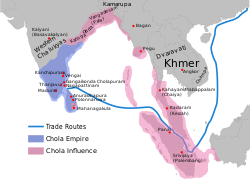Chodas
| Chola dynasty | ||||||||
|
||||||||
|
Map showing the extent of the Chola empire c. 1030
|
||||||||
| Capital | Early Cholas: Poompuhar, Urayur, Tiruvarur, Medieval Cholas: Pazhaiyaarai, Thanjavur Gangaikonda Cholapuram |
|||||||
| Languages | Tamil | |||||||
| Religion | Shaivism | |||||||
| Government | Monarchy | |||||||
| King | ||||||||
| • | 848–871 | Vijayalaya Chola | ||||||
| • | 1246–1279 | Rajendra Chola III | ||||||
| Historical era | Middle Ages | |||||||
| • | Established | 300s BCE | ||||||
| • | Rise of the medieval Cholas | 848 CE | ||||||
| • | Empire at its greatest extent | 1030 CE | ||||||
| • | Disestablished | 1279 CE | ||||||
|
||||||||
| Today part of |
possibly |
|||||||
The Chola dynasty was one of the longest-ruling dynasties in the history of southern India. The earliest datable references to this Tamil dynasty are in inscriptions from the 3rd century BCE left by Ashoka, of the Maurya Empire. As one of the Three Crowned Kings of Tamilakam, the dynasty continued to govern over varying territory until the 13th century CE.
The heartland of the Cholas was the fertile valley of the Kaveri River, but they ruled a significantly larger area at the height of their power from the later half of the 9th century till the beginning of the 13th century. The whole country south of the Tungabhadra was united and held as one state for a period of two centuries and more. Under Rajaraja Chola I and his successors Rajendra Chola I, Rajadhiraja Chola, Virarajendra Chola and Kulothunga Chola I the dynasty became a military, economic and cultural power in South Asia and South-East Asia. The power of the new empire was proclaimed to the eastern world by the expedition to the Ganges which Rajendra Chola I undertook and by the naval raids on cities of the maritime empire of Srivijaya, as well as by the repeated embassies to China. The Chola fleet represented the zenith of ancient Indian sea power.
...
Wikipedia

